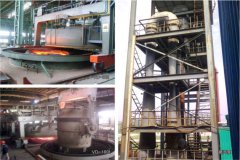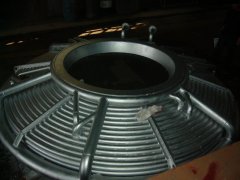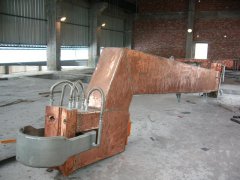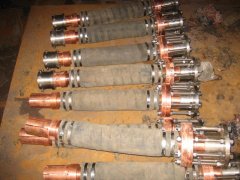Key Issues of Cleaner Smelting in EAF Steelmaking


Raw materials for smelting.
The main raw materials of EAF steelmaking are scrap steel and auxiliary materials are lime and carburizing agent. On the one hand, with the increasing number of scraps such as automobiles and household appliances, the composition of social scrap steel is more mixed; harmful impurity elements such as Cu, Zn, Pb, Sn in scrap steel are enriched with the increase of scrap cycle times. On the other hand, the use of auxiliary materials will also bring harmful elements, affecting the cleanliness of molten steel. In order to minimize the impact of raw materials, it is necessary to formulate different standards for the use of raw materials according to steel grades, and to make customized selection of raw materials and accessories according to steel grades. For example, when smelting high-quality alloy bars, hot metal plus scrap, high-quality scrap or high-quality scrap plus direct reduction iron are used as raw materials; when smelting low-sulfur steel, low-sulfur lime is used as far as possible; when smelting low-carbon steel, low-carbon auxiliary raw materials are selected.
Dephosphorization operation.
Phosphorus is a harmful element in most kinds of steel, and dephosphorization is one of the important tasks of EAF smelting. In recent years, with the development of national economy, the market demand for low phosphorus and ultra-low phosphorus high quality special steel has increased. The existing EAF steelmaking process is difficult to meet the requirements of fast and low cost dephosphorization. The main reason is that the raw material structure of EAF steelmaking is complex and the content of phosphorus fluctuates greatly; the carbon content of scrap steelmaking is low and the viscosity of molten steel is high after smelting, and the flow rate of molten pool is slow, the kinetics condition of dephosphorization is poor, and it is difficult to dephosphorize during smelting due to the restriction of EAF structure. Traditional electric arc furnace smelting low phosphorus steel usually adopts slagging and slagging operation for many times. The smelting cycle is long, the slag quantity is large, the content of final slag (FeO) is high, the peroxidation of molten steel is serious, and the smelting cost is difficult to control.
Control of oxygen and inclusions in steel.
The stable control of oxygen content in molten steel at the end point of EAF smelting is the key to reduce inclusions in steel. Intensified oxygen supply is widely used in EAF steelmaking to speed up the smelting rhythm and improve production efficiency. However, the end point control of EAF steelmaking is inaccurate and the peroxidation of molten steel is serious. This not only leads to excessive consumption of deoxidizers in the later refining process, but also increases the amount of inclusions in the refining process. In order to reduce the oxygen content in molten steel, the following measures are adopted in EAF steelmaking: controlling the oxygen content before tapping and strengthening stirring by injecting inert gas; controlling the slag content under eccentric bottom tapping during tapping; adding iron, carbon and magnesium balls before tapping to reduce the oxygen content in molten steel.
Control of [N] and [H] in steel.
Electric arc furnace uses high power supply to strengthen the melting of scrap steel. The high temperature arc generated by electrode discharge ionizes N2 in the air nearby, which makes the molten steel easy to absorb nitrogen. Sometimes N2 will be injected into the molten pool as bottom blowing gas or powder, which causes the molten steel to absorb nitrogen further. At the same time, the content of hydrogen in molten steel will be higher if the raw material of EAF contains water and contacts with air. However, due to the low carbon content and insufficient oxygen supply in the molten pool after smelting in EAF, the number of CO bubbles in the molten pool during decarbonization in the later stage of smelting is small, so [N], [H] can not be effectively removed. The main ways to solve these problems are to remove water and reduce hydrogen input by preheating scrap steel, adjust burden structure, increase carbon content of molten pool by adding DRI and increasing molten iron ratio, and carry out high intensity decarbonization boiling operation in the later stage of arc furnace smelting to remove [N], [H], and then refining in the following stage. The content of [N], [H] in steel can be controlled by protection during casting.
The main raw materials of EAF steelmaking are scrap steel and auxiliary materials are lime and carburizing agent. On the one hand, with the increasing number of scraps such as automobiles and household appliances, the composition of social scrap steel is more mixed; harmful impurity elements such as Cu, Zn, Pb, Sn in scrap steel are enriched with the increase of scrap cycle times. On the other hand, the use of auxiliary materials will also bring harmful elements, affecting the cleanliness of molten steel. In order to minimize the impact of raw materials, it is necessary to formulate different standards for the use of raw materials according to steel grades, and to make customized selection of raw materials and accessories according to steel grades. For example, when smelting high-quality alloy bars, hot metal plus scrap, high-quality scrap or high-quality scrap plus direct reduction iron are used as raw materials; when smelting low-sulfur steel, low-sulfur lime is used as far as possible; when smelting low-carbon steel, low-carbon auxiliary raw materials are selected.
Dephosphorization operation.
Phosphorus is a harmful element in most kinds of steel, and dephosphorization is one of the important tasks of EAF smelting. In recent years, with the development of national economy, the market demand for low phosphorus and ultra-low phosphorus high quality special steel has increased. The existing EAF steelmaking process is difficult to meet the requirements of fast and low cost dephosphorization. The main reason is that the raw material structure of EAF steelmaking is complex and the content of phosphorus fluctuates greatly; the carbon content of scrap steelmaking is low and the viscosity of molten steel is high after smelting, and the flow rate of molten pool is slow, the kinetics condition of dephosphorization is poor, and it is difficult to dephosphorize during smelting due to the restriction of EAF structure. Traditional electric arc furnace smelting low phosphorus steel usually adopts slagging and slagging operation for many times. The smelting cycle is long, the slag quantity is large, the content of final slag (FeO) is high, the peroxidation of molten steel is serious, and the smelting cost is difficult to control.
Control of oxygen and inclusions in steel.
The stable control of oxygen content in molten steel at the end point of EAF smelting is the key to reduce inclusions in steel. Intensified oxygen supply is widely used in EAF steelmaking to speed up the smelting rhythm and improve production efficiency. However, the end point control of EAF steelmaking is inaccurate and the peroxidation of molten steel is serious. This not only leads to excessive consumption of deoxidizers in the later refining process, but also increases the amount of inclusions in the refining process. In order to reduce the oxygen content in molten steel, the following measures are adopted in EAF steelmaking: controlling the oxygen content before tapping and strengthening stirring by injecting inert gas; controlling the slag content under eccentric bottom tapping during tapping; adding iron, carbon and magnesium balls before tapping to reduce the oxygen content in molten steel.
Control of [N] and [H] in steel.
Electric arc furnace uses high power supply to strengthen the melting of scrap steel. The high temperature arc generated by electrode discharge ionizes N2 in the air nearby, which makes the molten steel easy to absorb nitrogen. Sometimes N2 will be injected into the molten pool as bottom blowing gas or powder, which causes the molten steel to absorb nitrogen further. At the same time, the content of hydrogen in molten steel will be higher if the raw material of EAF contains water and contacts with air. However, due to the low carbon content and insufficient oxygen supply in the molten pool after smelting in EAF, the number of CO bubbles in the molten pool during decarbonization in the later stage of smelting is small, so [N], [H] can not be effectively removed. The main ways to solve these problems are to remove water and reduce hydrogen input by preheating scrap steel, adjust burden structure, increase carbon content of molten pool by adding DRI and increasing molten iron ratio, and carry out high intensity decarbonization boiling operation in the later stage of arc furnace smelting to remove [N], [H], and then refining in the following stage. The content of [N], [H] in steel can be controlled by protection during casting.
Huachang company specialized in metallurgical equipment, industrial furnace development and manufacturing project construction comprehensive service providers, to provide one-stop professional services!
If you are looking for related products or have any other problems, you can call the company service hotline at any time, or click the button below to communicate with us online!
Customer Service Hotline
:086-88864421








